California is a huge state, hence the diverse range of bird species that can be found there. Some of these species migrate to California only during the summer or winter, while others remain in the state all year. We’ll look at 27 of the most prevalent backyard birds in California and learn a bit about each one in this article.
After that, I’ll teach you how to entice them to your yard, as well as a crash course in the 10 distinct sorts of bird feeders available. Finally, I’ll share a few favorite local birding organizations and some great birdwatching locations in California.
How many different species of wild birds are in California?
It’s impossible to calculate exactly how many bird species live in North America, the United States, or even in the state of California. As of 2021, however, at least 676 species of birds have been seen in the state of California, according to the California Bird Records Committee. There are 2,059 species in North America, according to one source, but just 914 species according to another. These numbers tell us a broad idea of the number of species, but I’m not sure how much I trust them.
We’re just going to examine a few of the species that commonly appear in California, particularly in backyards, for the sake of this article.
27 COMMON BACKYARD BIRDS IN CALIFORNIA
In California, we’ll take a look at 27 different species of backyard birds, including some migrants. They aren’t all of the species in California, and they aren’t even close to it, but these are some of the birds that are most likely to visit backyards. Let’s get started!
1. BLACK PHOEBE
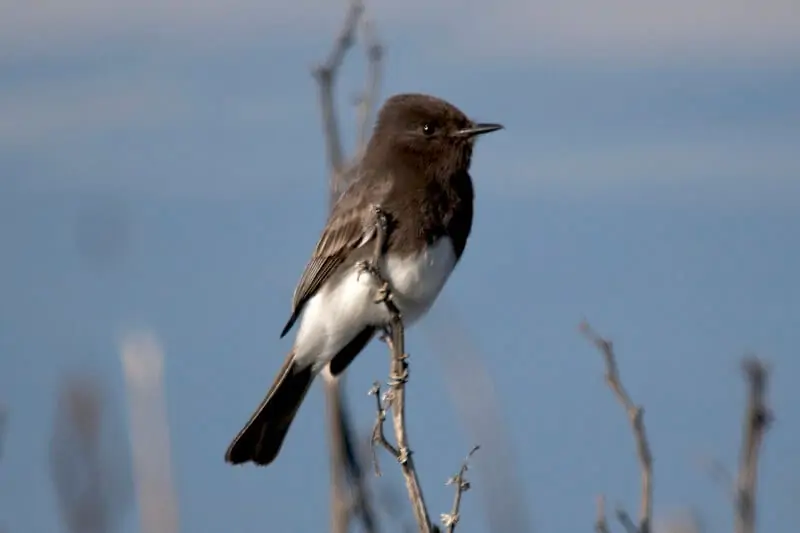
Scientific name: Sayornis nigricans
Length: 6.3 in
Weight: 0.5-0.8 oz
Save for their white belly, Black Phoebe is sooty and dark in color. Their beak is small and black, and their skull seems to have a convex appearance. The diet of black Phoebe’s is practically entirely flycatchers, or flies, beetles, spiders, bees, and grasshoppers. They are part of the flycatcher family. They like to perch low to the ground and pump their tail up and down frequently.
Throughout the year, Black Phoebes may be seen in California’s coastal regions, however they are uncommon in the state’s interior and east.
Black Phoebes are insectivorous, so they won’t go to a birdseed feeder. Offering mealworms or having native plants that support insects may help you attract them.
2. ANNA’S HUMMINGBIRD

Scientific name: Calypte anna
Length: 3.9 in
Weight: 0.1-0.2 oz
Wingspan: 4.7 in
Along the western coast of the United States, the Anna’s Hummingbird is one of the most common hummers. The throat, forehead, and behind the eyes of male birds are green, with a light breast. The strong pink feathers are not seen in females, although there are occasional pink/red dots on the neck. Hummingbirds migrate to the southern United States throughout the winter, but Anna’s generally remain in place in the western United States, only traveling modest distances if they require a new food source.
Throughout most of California, the Anna’s Hummingbird may be seen year-round, however in the state’s northwestern section, they are only seen during the spring and summer.
If you set out a nectar feeder or nectar-producing plants, Anna will happily visit backyards.
3. NORTHERN MOCKINGBIRD
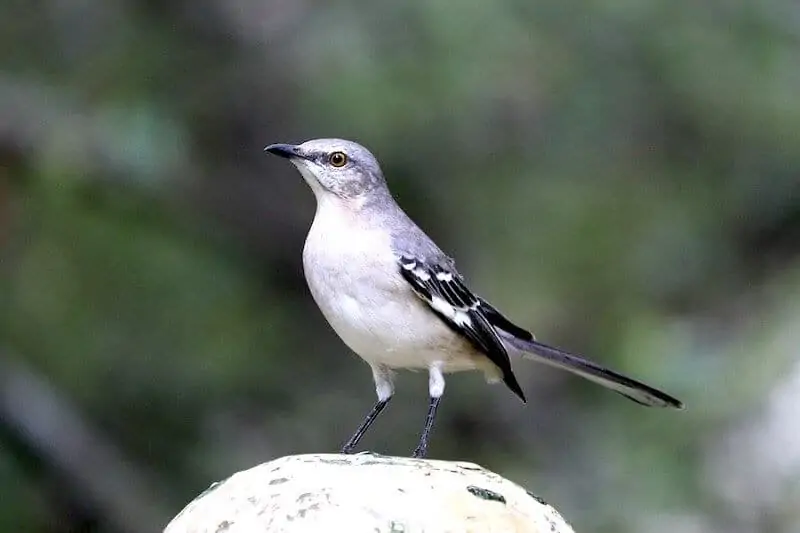
Scientific name: Mimus polyglottos
Length: 8.3-10.2 in
Weight: 1.6-2.0 oz
Wingspan: 12.2-13.8 in
The ability of mockingbirds to imitate the songs of other birds gives them their name. According to research, a mockingbird male might learn up to 200 songs throughout its lifetime. The tail feathers of these medium-sized yard birds are rather lengthy, and they are mostly gray and white in color. They’re frequently found lurking in tall vegetation, and they may be quite vicious when it comes to invading birds.
Throughout most of California, Northern Mockingbirds may be found year-round. They may only be found during the spring and summer months along the country’s northwestern border.
Backyards are home to a lot of Northern Mockingbirds, but they don’t eat bird feeders. Using some of the other ideas listed below, such as fruit-bearing shrubs and a bird bath, you can entice them to your yard.
4. CALIFORNIA SCRUB-JAY

Scientific name: Aphelocoma californica
Length: 11.0-11.8 in
Weight: 2.5-3.5 oz
Wingspan: 15.3 in
The beautiful blue color on the head, back, and tail of the California Scrub-Jay is a very big songbird. A patch that might be gray or brown may be seen across their upper back. With some blue feathers around the front that look like a necklace, its chest and belly are largely white. Both their frequent vocalizations and the way they bounce around and seem to be cocking their heads and hatching schemes have earned them a reputation for being boisterous. Throughout the spring and summer, they eat mostly fruit and insects, then nuts, seeds, and acorns throughout the winter.
The California Scrub-Jay may be found across northern, coastal, and central California throughout the year. In the state’s center and south-eastern regions, they might be less prevalent to uncommon.
Fruit-bearing trees attract scrub jays in the summer, while acorn-producing oak trees attract them in the winter. Sunflower seeds and peanuts will be available for them at bird feeders.
5. WHITE-CROWNED SPARROW

Scientific name: Zonotrichia leucophrys
Length: 5.9-6.3 in
Weight: 0.9-1.0 oz
Wingspan: 8.3-9.4 in
During the summer, white-crowned sparrows are found in Canada and Alaska, and during the winter, they migrate back across the United States. White-crowned sparrows have a bold black and white striped head, with the remainder of their face, chest, and belly remaining a plain buffy brown-gray. They are one of the easier sparrows to identify. They like to forage along the borders of roads and trails, as well as in fields. Sparrows like to visit bird feeders, but they will more often pick up spilled seed on the ground.
These sparrows will only be seen throughout the winter in much of California. Many, however, remain year-round along the coast.
Feeders are visited by white-crowned sparrows, who adore to collect fallen seed below feeders. Sunflower, millet, and a variety of seed mixtures are available.
6. RED-WINGED BLACKBIRD
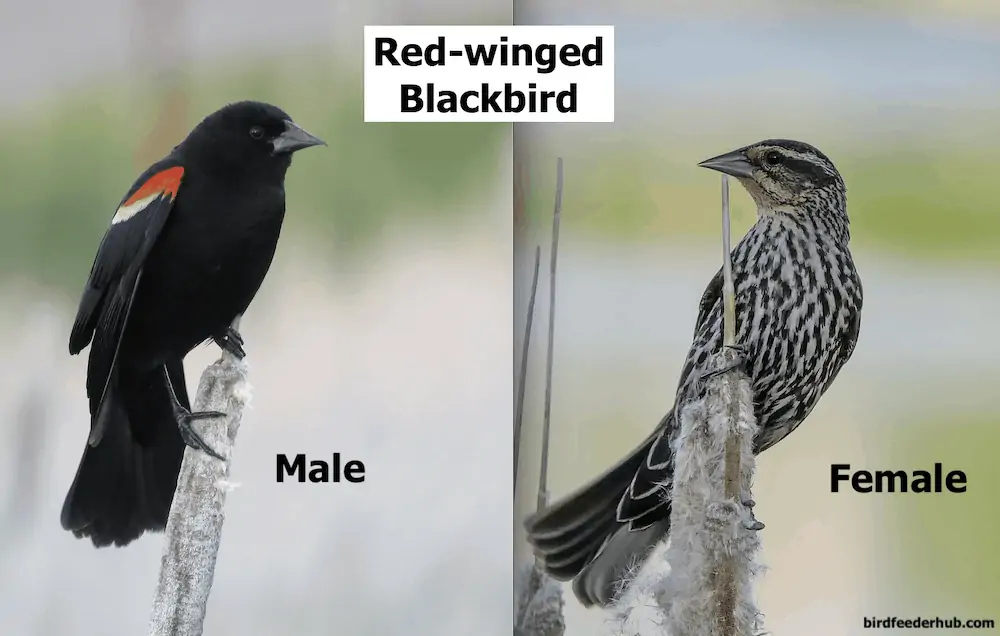
Scientific name: Agelaius phoeniceus
Length: 6.7-9.1 in
Weight: 1.1-2.7 oz
Wingspan: 12.2-15.8 in
Male Red-winged Blackbirds are easily recognized due to their crimson and yellow “shoulders,” which stand out against their black bodies among the most common birds in North America. The females, on the other hand, are brown with light streaks and look quite different than the males. Males will have up to 15 distinct females that they are mating with, making them a polygynous species. Unfortunately, they arrive at feeders in large flocks and devour seed quickly.
Throughout California, you may see red-winged blackbirds throughout the year.
Most types of feeders are visited by red-winged blackbirds, who will eat both seed and suet.
7. AMERICAN ROBIN

Scientific name: Turdus migratorius
Length: 7.9-11.0 in
Weight: 2.7-3.0 oz
Wingspan: 12.2-15.8 in
Robins, which are common in backyards and prefer to hop around the grass searching for worms and other invertebrates, are most commonly seen. They do not often eat seeds, although they will occasionally visit birdfeeders. They are easily identified by their bright orange spherical bellies, yellow beaks, and size. From dawn until dusk, they’re known for their frequent singing.
The majority of the year, robins live throughout California, although they are only present during the winter in the southern tip of the state.
Attract American Robins to seed feeders with meal worms, native fruit-bearing trees, or a bird bath. They are not often seen at seed feeders.
8. MOURNING DOVE

Scientific name: Zenaida macroura
Length: 9.1-13.4 in
Weight: 3.0-6.0 oz
Wingspan: 17.7 in
Doves are tiny birds that frequent backyards and may sit perched on power lines or in clusters in trees. They are about the size of a robin. They’re sometimes seen walking around on the ground beneath hanging bird feeders, but more often than not, I see them on my tray feeder. Mourning Doves have gray plumage with black splotches on top and pink legs. The plumage below is pale peach. Males and females appear to be the same in appearance.
Throughout California, Mourning Doves stay throughout the year.
Dove feeders are popular, but dove prefer to scour the ground for fallen seeds. Sprinkle some seeds on the ground, or use a ground feeder with a mixed seed blend.
9. EUROPEAN STARLING
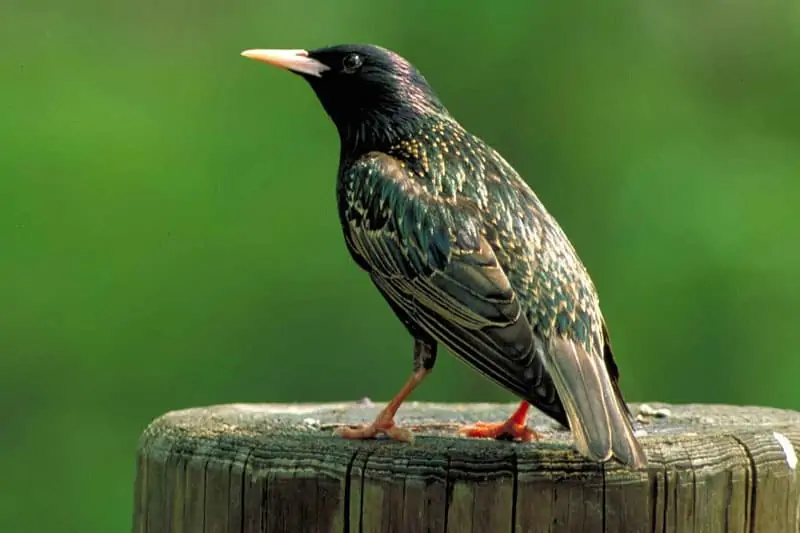
Scientific name: Sturnus vulgaris
Length: 7.9-9.1 in
Weight: 2.1-3.4 oz
Wingspan: 12.2-15.8 in
In the 1890s, 100 starlings were released in New York, and they have since conquered the United States. They kill the eggs and chicks of other birds, destroy their nests, and obstruct feeders so that no other birds can access the food you provide. They have yellow beaks and feet and are mostly dark with white specks on their backs and wings. At the right angle, starlings may also be quite lovely. They are a purple and green iridescent color.
Every year-round, starlings may be found in all of the lower 48 states, including California.
Anything is edible to European Starlings. Since they are an invasive species, we suggest that you do not try to attract them; they will find their way in.
10. BUSHTIT
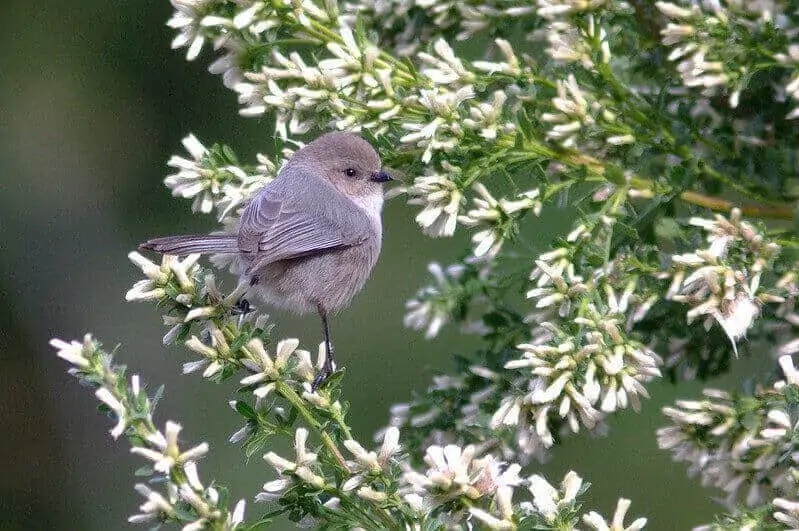
Scientific name: Psaltriparus minimus
Length: 2.8-3.1 in
Weight: 0.1-0.2 oz
Bushtits are a little bird with a round, fat appearance. Their tones may vary somewhat depending on where they are, yet they have a buffy brownish-gray hue with a somewhat lighter neck, which is common in California. They are common and have a simple coloration that makes them difficult to see. Look for them in bushes and thickets, moving from branch to branch. These birds are frequently seen in groups, and because of their constant insect-hunting, they don’t stay still for long.
The coast and the northern and eastern borders of California are year-round habitats for Bushtits. Along the state’s central corridor and southeastern corner, they may be missing or uncommon.
Because birds don’t like insects, they aren’t attracted to feeders. Attracting them to your yard with the help of native shrubs and trees that feed the insects they want may be beneficial.
11. HOUSE FINCH
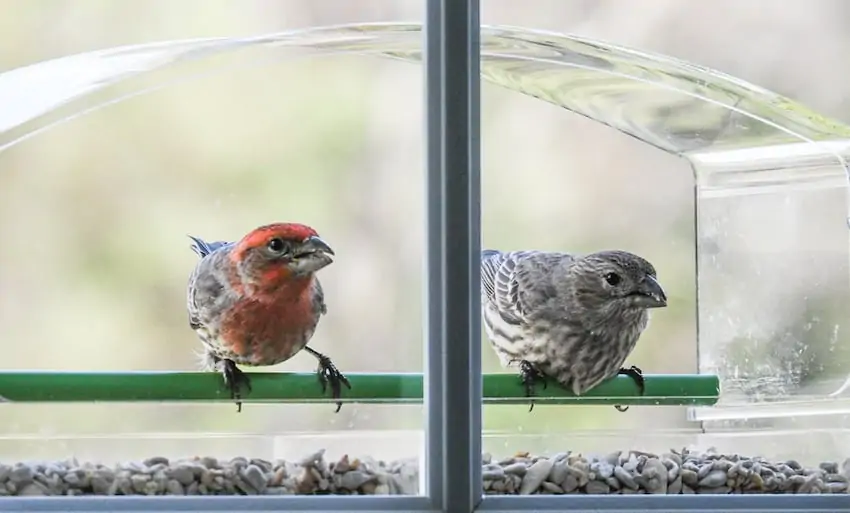
Scientific name: Haemorhous mexicanus
Length: 5.1-5.5 in
Weight: 0.6-0.9 oz
Wingspan: 7.9-9.8 in
Within their range, the House Finch is a very common backyard bird. They didn’t spread to the eastern United States, and they’re west coast natives. They were trying to sell caged finches until the 1940s, when they were set free. They may appear in little flocks and mob your feeders if you attract them, which is very easy to do. Brown with considerable white streaking, both sexes are brown. The head, chest, and back of males are splashed with red.
All year round, California has a diverse population of House Finches.
Black sunflower or mixed seed attract House Finches, who will devour it. House Finches, like other finches, will eat thistle seeds.
12. HOUSE SPARROW

Scientific name: Passer domesticus
Length: 5.9-6.7 in
Weight: 0.9-1.1 oz
Wingspan: 7.5-9.8 in
House Sparrows are the only other wild bird species in the United States, and they’re generally seen as pests. besides starlings, which may be trapped and killed humanely. They, like starlings, were first brought to New York in the 1800s and have since spread across the United States like wildfire. Their wings and buffy chest are speckled with black and brown streaking, and they are generally brown in hue. With a black mask and chest, males are often noticeable. They Target other birds, particularly around nests and birdhouses, and they are aggressive in general.
Throughout California, House Sparrows may be found year-round.
House Sparrows, like European Starlings, are invasive and pose a danger to indigenous animals. Most types of seed will be eaten by them.
13. YELLOW-RUMPED WARBLER

Scientific name: Setophaga coronata
Length: 4.7-5.5 in
Weight: 0.4-0.5 oz
Wingspan: 7.5-9.1 in
Depending on its location, the Yellow-rumped warbler’s color pattern might change. The “Audubon’s” variety, which features a brilliant yellow throat, rump, and sides, is the most common in California. On top of their head, you may see a little hint of yellow. The color pattern of females is the same as that of males, but they may seem duller and the markings may be less distinct. Their colors will be the most vivid and brilliant in the spring, but they will fade considerably over the winter, as do those of other warblers.
In California, there is a significant variation in location. There are year-round inhabitants as well as seasonal breeders in the north, especially in the spring and summer. During the winter months, Yellow-rumped warblers are more common in the southern part of the state.
Bird feeders are occasionally visited by Yellow-rumped Warblers. Sunflower seeds, suet, and raisins are all good ways to attract them.
14. CALIFORNIA TOWHEE

Scientific name: Melozone crissalis
Length: 8.3-9.8 in
Weight: 1.3-2.4 oz
Wingspan: 11.4 in
The Towhee family of birds includes the California Towhee. They have rusty brown specks around the eye, on the cheeks, and beneath their tail. They’re a dusty gray-brown color overall. They’re known to tap on your window, car mirror, or other reflective surface frequently, so you may often encounter them. The white berries of poisonous oak are favorites of these towhees, who prefer to construct their nests there.
Throughout the year, California Towhees may be more common in the state’s western half.
Using a ground tray or scattering seed, you may be able to encourage these towhees to visit your feeder in the backyards. Mixed seed mixtures, such as millet, are their favorites.
15. SONG SPARROW
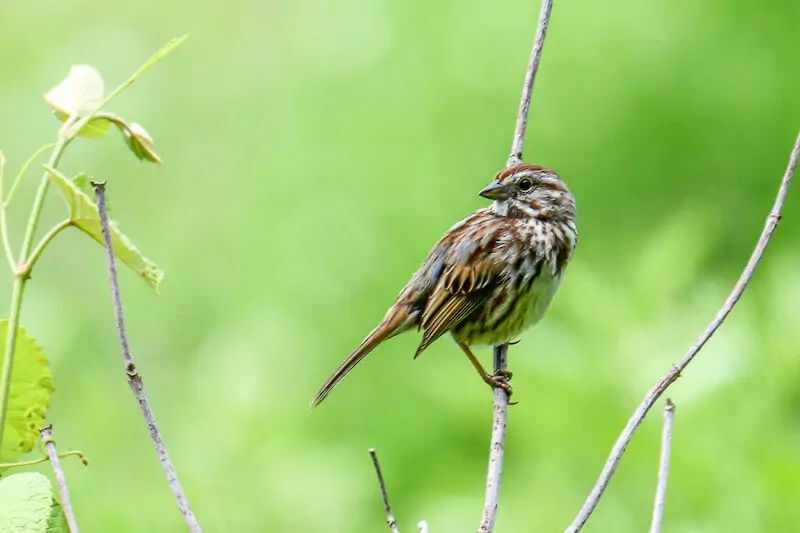
Scientific name: Melospiza melodia
Length: 4.7-6.7 in
Weight: 0.4-1.9 oz
Wingspan: 7.1-9.4 in
The plumage of song Sparrows varies somewhat depending on the area they are found. The back and wings of these sparrows are mostly brown, with a light belly and heavy brown streaks on the chest. The song of a song sparrow on the California coast might be darker, greyer, and streaked with heavier streaks. In addition to attracting females, the male of this species uses his song to defend his territory.
Song Sparrows may be seen all year around California, however the birds are only present in the state’s southern section during the winter.
Song Sparrows will pick through mixed seeds and sunflower seeds at bird feeders on occasion.
16. LESSER GOLDFINCH

Scientific name: Spinus psaltria
Length: 3.5-4.3 in
Weight: 0.3-0.4 oz
Wingspan: 5.9-7.9 in
As shown above, the male Lesser Goldfinch has a black head, yellow belly, and white wings with black markings. California birds may have a dark glossy black plumage that extends over their whole head and back, which is another variation. The underside of females is yellow, with an olive-colored head and back. These finches, along with other goldfinches, house finches, and sparrows, are frequently found in a mixed flock.
The Greater Goldfinch may be found across most of California during the year. They may only be seen in the spring and summer in the northeastern corner.
Sunflower seeds and nyjer (thistle) seed are favorite foods of Lesser Goldfinches, who will visit bird feeders.
17. RUBY-CROWNED KINGLET

Scientific name: Regulus calendula
Length: 3.5-4.3 in
Weight: 0.2-0.3 oz
Wingspan: 6.3-7.1 in
The olive green kinglet has white wing bars, yellow-edged wings, and tail feathers with a white eye ring. While the guy is excited, he may show a little patch of bright crimson feathers on top of his skull, although this is usually covered. They’re high-energy foragers who dart through shrubs and trees, flick their wings, and so on. Wing-flicking is a common behavior that may help with identification. They can lay up to 12 eggs at a time, which is amazing for such a small bird.
The Ruby-crowned Kinglet is a winter visitor to most of California, however during the breeding season, they may nest in pockets throughout the northern part of the state.
Bird feeders are a favorite attraction for Ruby-crowned Kinglets. Sunflower chips, suet, peanut pieces, and mealworms are all supposed to attract them.
18. SPOTTED TOWHEE

Scientific name: Pipilo maculatus
Length: 6.7-8.3 in
Weight: 1.2-1.7 oz
Wingspan: 11.0 in
The Spotted Towhee is a delightful backyard bird that’s always a delight to see. With white wing patches, rusty sides, and a white belly, both sexes have a black head, back, wings, and tail. Males have a dark complexion, whereas womales have a brown complexion. Towshees look for insects, seeds, and berries among the leaves of the forest while master foragers. It’s amusing to observe them scratching at the ground and moving brush, performing a doubled-footed backwards hop motion. Leave some brushy edges and leaf litter along your yard line to improve the chance of attracting towhees to your yard.
Throughout most of California, Spotted Towhees may be found year-round, although they are scarce in the state’s southeast corner.
Spotted Towhees prefer to hunt for seed on the ground beneath feeders rather than eat from bird feeders on a regular basis. Leave some prickly grass in the yard to attract them, or scatter seed on the ground.
19. NORTHERN FLICKER

Scientific name: Colaptes auratus
Length: 11.0-12.2 in
Weight: 3.9-5.6 oz
Wingspan: 16.5-20.1 in
In the backyards of America, these medium to big woodpeckers are rather frequent. They’re also one of the most stunning birds in North America, in my opinion. Flickers prefer to eat insects instead of foliage, unlike other woodpeckers, who prefer to eat them high in the tree. The solid black bib, buffy brown on the face, and barred black and gray wings will help you identify them. Males have a crimson “mustache,” whereas females do not. The red-shafted variety is found in California, with crimson feathers on the underbelly of their wings and tail.
Throughout California, Northern Flickers can be found year-round.
Northern Flickers will visit suet feeders even if they do not visit feeders as often as other woodpecker species. You may observe them digging for insects in your yard if you have some leaf mounds.
20. DARK-EYED JUNCO

Scientific name: Junco hyemalis
Length: 5.5-6.3 in
Weight: 0.6-1.1 oz
Wingspan: 7.1-9.8 in
Because they spend their summers in Canada, juncos are often regarded as winter birds in the United States. They’re little birds with a light pink beak that fly around the United States in a circular pattern. Their feather colors range. The Oregon variety is common in California. The back is brown, while the chest is pale. The heads of females are gray, and their color is less vibrant than males. Juncos, who hopping about on the ground are particularly frequent in wooded regions and forests.
While there are areas along the shore and in northern California where Dark-eyed Juncos may be seen all year, they are more typically sighted in California during the winter months.
Juncos prefer to eat seed from the ground beneath your feeders, rather than visiting feeders on occasion. Mixed seeds are a big hit with them.
21. CHESTNUT-BACKED CHICKADEE
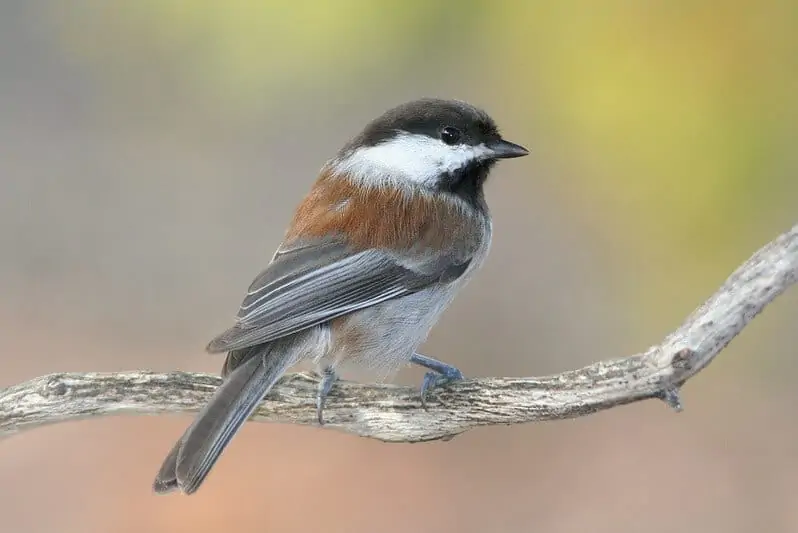
Scientific name: Poecile rufescens
Length: 3.9-4.7 in
Weight: 0.3-0.4 oz
Wingspan: 7.5 in
Because of their black cap and black bib, chickadees are tiny little birds that are quite easy to identify. All the way up the west coast of North America, this western bird may be found. It has a chestnut back and sides in the northern parts of its range. Just a chestnut back with light sides is more common in California. Many animals, including rabbits and deer, provide fur to the chicksadees as they build their nests. They’re quick and inquisitive birds that may seem quite courageous around human-feeding bird feeders.
Central and coastal California are home to the most common members of this group, the Chestnut-backed Chickadees.
Most seed feeders will be visited by chickadees, who will offer black sunflower seeds and mixed seed blends.
22. WESTERN BLUEBIRD

Scientific name: Sialia mexicana
Length: 6.3-7.5 in
Weight: 0.8-1.1 oz
Wingspan: 11.4-13.4 in
The head, neck, wings, and tail of male Western Bluebirds are all blue. Their breast is a rusty orange, which extends down their sides and across their wings and back. Females will have no blue on their throat and will seem duller, sometimes significantly so. In the United States, they are perhaps the most desired occupants of birdhouses. The bluebird house industry has become quite popular. Backyards, especially feeders, are full of them. Try to attract a mating pair with a birdhouse.
Much of California is home to Western Bluebirds, although they are scarce in the southeast. To learn more about the California Bluebird Recovery Program, visit it.
Most of California is home to Western Bluebirds, although they are absent in the southeastern part. To learn more about the California Bluebird Recovery Program, check it out.
23. OAK TITMOUSE

Scientific name: Baeolophus inornatus
Weight: 0.3-0.7 oz
The nondescript Oak Titmouse is a little bird. With a lighter chest, they have a grayish-brown head and back. You may easily identify them by observing the peak on top of their head, although it might sometimes be hidden due to their movements. Warm, dry oak or pine-oak woodlands are their natural environment, as the name implies. These are often seen eating seeds as well as insects and moving tree to tree in search of food. By placing a nestbox in your yard, you may entice them.
They’re most frequently seen during breeding season in California, where they have a limited range. Look for them along the south Baja coast, in the middle valley, and in the Cape District. Certain tiny populations may remain year-round in a few locations.
Sunflowers and mixed seeds are welcome on bird feeders by the Oak Titmouse. They like it when there are trees around the feeders.
24. BEWICK’S WREN
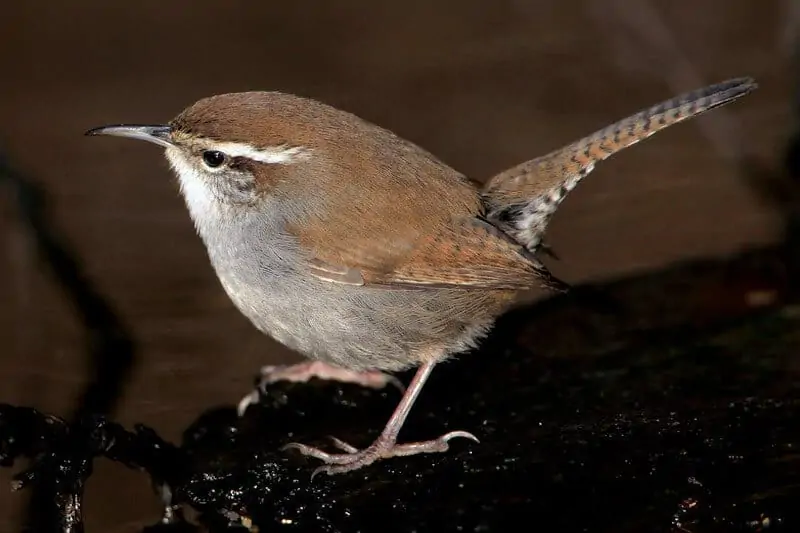
Scientific name: Thryomanes bewickii
Length: 5.1 in
Weight: 0.3-0.4 oz
The body of Bewick’s Wren is rounded, and the chest is light. The bill of this wren is long and has a somewhat downward bend, as with other wrens. The wings and tail have black markings, and the head has a white “eyebrow.” They may range from a warm brown in humid areas to a more gray-brown in drier areas. They’re constantly hopping from branch to branch, flicking their tail up and down all the while. Males are small, but they can remember up to 22 distinct songs and are quite loud singers.
Throughout central and northern California, as well as along the coast, the Bewick’s Wren may be found all year. At the state’s extreme southern corner, they only have a winter range.
All year round, central and northern California, as well as the coast, are home to the Bewick’s Wren. At the state’s far southern tip, they have a winter-only range.
25. STELLER’S JAY

Scientific name: Cyanocitta stelleri
Length: 11.8-13.4 in
Weight: 3.5-4.9 oz
Wingspan: 17.3 in
Jay, Steller’s bird, is a beautiful creature! On the top half, they are huge birds with brownish-black feathers, and on the bottom half, they are bright blue. During courtship or in aggression, these jay’s have a gigantic crest that they may flick and show off to great effect. They prefer evergreen woods as their primary habitat, but they may be found in campsites, parks, and yards across their territory.
Steller’s Jays are most common in northern California throughout the year, although they may also be seen along the coast and forested areas east of there. In state forests, such as those in San Bernardino, they may also be seen.
Place peanuts, big seeds, and nuts in bird feeders to attract the Steller’s Jay.
26. COMMON RAVEN

Scientific name: Corvus corax
Length: 22.1-27.2 in
Weight: 24.3-57.3 oz
Wingspan: 45.7-46.5 in
Common Ravens are solid black in color, and quite large in size. They are also know for being highly intelligent problem solvers, like their cousin the crow. They seem equally at ease living alongside human activity as out in very remote wilderness. Ravens can make a large number of different vocalizations, the most common sound like a series of croaks.
Year-round, ravens may be found across California.
Omnivorous common Ravens are too big to fit in bird feeders, thus they don’t go there. However, keep an eye on your trash and pet feeding outside.
27. GOLDEN-CROWNED SPARROW

Scientific name: Zonotrichia atricapilla
Length: 5.9-7.1 in
Weight: 1.1-1.2 oz
The body of the Golden-crowned Sparrow is typical of sparrow coloration, and it is a bigger sparrow. Brown with a gray body has black and white streaked wings. Their signature color is a brilliant yellow patch in the centre of their black headgear. These colors’ heads may grow darker with a less apparent yellow patch in the winter, and they may lose their sharpness. They migrate south into the United States, where they breed in Alaska and British Columbia’s far north. Winter is the time for something like this.
Only in California’s fall and winter, particularly in the state’s northern and western regions, can Golden-crowned Sparrows be found.
Bird seed is eaten by these sparrows, but they prefer to eat on the ground. Sprinkle your seed or use a ground feeder.
HOW TO ATTRACT BIRDS TO YOUR YARD
Do you want to bring some of these birds into your garden? Starting with the most obvious, take a look at these five simple tips.
1. PUT OUT BIRD FEEDERS
Putting up a bird feeder or two is the greatest and most apparent strategy to attract birds to your yard. A basic tube feeder, hopper feeder, platform feeder, or window feeder are good places to start. For each, there are ideas below.
2. ADD A WATER SOURCE
This Amazon-exclusive pedestal birdbath is fantastic, but you can use a terra cotta flower pot saucer, such as the one shown here. Adding a water feature to your yard will only increase your chances of attracting birds, as birds need water not only to bathe in but also to drink. Also, since moving water will draw the birds in even more, consider adding a solar fountain.
3. OFFER BIRDHOUSES
If placed in the proper position at the proper time of year, several bird species will readily take up residence in birdhouses. Among the most common birds sought after for birdhouses are Eastern Bluebirds. A mating pair of bluebirds was inspecting this birdhouse in my yard the very same day I put it up.
4. PROVIDE SHELTER
When birds sense danger, make certain that your yard has trees, shrubs, and bushes for them to dart back and forth between. Predators are their primary defense mechanism. Do your best to add some landscaping elements that will allow birds to view your yard as safe if your garden is in a new development with no mature trees.
5. ADD NATIVE PLANTS
Having native plants that produce nuts, berries, and seeds will merely help your efforts to attract more birds for many birds that eat them. Moreover, since most songbirds feed insects to their hatchlings, native plants help caterpillars and other insects that feed numerous birds and support nesting birds. Maximize the diversity of native flora by avoiding invasive and non-native flora, which may usurp native flora.
10 DIFFERENT TYPES OF BIRD FEEDERS
These are the most popular bird feeders that people put up in their yards.
- The term “hopper feeder” refers to a bin in the middle of the device, called a hopper, that holds bird seed. Perches on the sides provide landing sites for birds and food. To keep the seed dry, many hopper feeders are shaped like a house and have a roof. For this kind of feeder, use black sunflower seeds or a combination of birdseed. This is one of my favorite hopper feeders, and it’s squirrel-proof as well.
- Platform feeders are open on top and may be hung from a tree or hook, or pole-mounted. They are often referred to as tray feeders. They’re super easy to set up and are ideal for feeding most types of birds. Every animal in your yard that can reach them will devour them, despite the fact that they are entirely open. For this kind of feeder, use black sunflower seeds or a combination of birdseed. In the meanwhile, I’m using an outdoor platform feeder.
- Tube feeders are simply transparent plastic tube-shaped bird feeders that you put out for birds. They may hold from a few cups of seed to 5 pounds or more, and they come in a variety of sizes. They’re great because they allow you to easily seed when it needs to be refilled, while also keeping your seed fresh and dry. Tube feeders are used by many types of birds. In tube feeders, you can mix black sunflower seeds with other seeds. This is a great squirrel proof tube feeder from Squirrel Buster, one of the best on the market.
- Suet feeders, also known as suet cake feeders, are used by one kind of bird. They are a rather basic design, generally consisting of a metal wire cage with a tail-prop for bigger birds. Suet feeders are common during the winter, when woodpeckers come to visit and birds are seeking high-fat foods. I suggest getting a suet feeder with a long tail prop to attract larger woodpeckers, such as the Pileated and Northern Flicker.
- Window feeders are small bird feeders that use suction cups to mount onto a glass window. Tray feeders are open on top and you simply pour seed into the tray to refill them, so they’re comparable. These feeders are preferred by a wide range of species, are simple to set up, and ideal for anyone with small gardens. For this sort of feeder, use black sunflower seeds or a combination of birdseed. This is, by far, the most popular bird feeder on Amazon, as well as the most popular window feeder.
- Thistle feeders, sometimes known as Nyjer feeders, are specialized bird feeders designed for thistle seed. Birds belonging to the finch family, which includes the American Goldfinch and House Finch, are among the most common types of birds attracted to thistle feeders. Thistle feeders are usually tube-shaped and include tiny holes along the tube’s circumference that allow birds to eat the thistle. Droll Yankees has a great thistle feeder.
- Tray feeders that sit on the ground level are known as ground feeders. Birds like Mourning Doves and Juncos, as well as squirrels, raccoons, and other ground animals will love them. For this type of feeder, use black sunflower seeds or a combination of birdseed. This ground feeder made of recycled plastic is a great choice.
- Another kind of specialized feeder for just one species of bird, orioles, is the oriole feeder. Little plastic or glass dishes designed for holding jelly, which orioles adore, are frequently used as feeders. Another food that orioles enjoy is orange halves, which they can stick onto the feeder. With four jelly trays, this simple oriole feeder can hold orange halves.
- Hummingbird feeders are sugar water extractors that are specifically designed for hummingbirds. I frequently see Downy Woodpeckers at mine, even though they are meant for hummingbirds, and they love that sweet nectar as much as I do. Learn how to make hummingbird nectar without boiling the water by reading this article. There is no need to pay a lot of money for a hummingbird feeder since they are so simple and cheap. Here’s one I’ve personally used and liked.
- Peanut feeders are tube-shaped and usually made of metal wire mesh material, similar to thistle feeders. To allow for either whole unshelled or shelled peanuts to pass through the holes, the holes in the wire mesh are spaced much farther apart. These feeders should be filled with peanuts and attract birds such as Blue Jays. Squirrel Buster’s peanut feeder is the best way to keep squirrels out if you want to do so. This basic one will suffice.
BIRD WATCHING IN CALIFORNIA
If you want to take your hobby outside of your own yard, California is a wonderful state for birding. If you want to get a little more involved with the California Audubon Society, there are numerous regional chapters and regular meetups, workshops, field excursions, and birding tours.
Take a look at this list I’ve put together of some popular birding sites in California if you’re a California resident who’d want to add some new species to your life list.
CALIFORNIA BIRDING LOCATIONS
(and local birding events and festivals) learn more about what each of these locations has to offer
- Point Reyes
- MacKerricher State Park
- Arcata Marsh & Wildlife Sanctuary
- Henry W. Coe State Park
- Anza-Borrego Desert State Park
- Ahjumawi Lava Springs State Park
